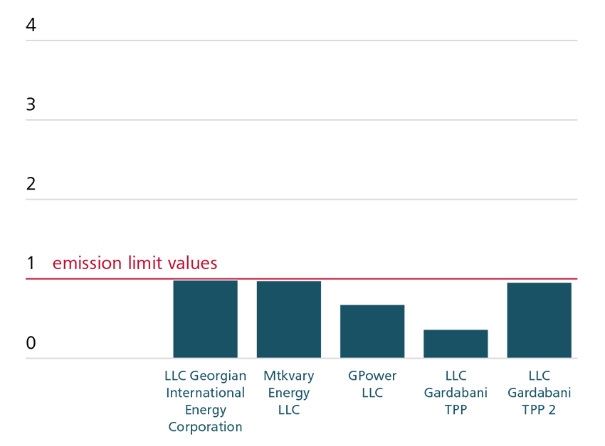
Georgia

 Membership
Membership
-
Overall implementation performance
Overall implementation performance 2023
CLUSTER INDICATORS 2023 HIGHLIGHTS AND NEXT STEPS .2023-12-08-13-48-12.png)
Markets and integration The Government postponed the opening of the electricity day-ahead, intraday, balancing and ancillary services markets for 1 July 2024. The implementation of natural gas market concept design, gas market rules, gas distribution rules, unbundling of gas distribution system operator has also been postponed. Georgia should strive to open the wholesale electricity and gas markets and urgently finish the unbundling and certification of the electricity and gas transmission system operators, along with the transposition and implementation of the Electricity Integration Package. 
Decarbonising the energy sector Georgia has submitted its draft NECP to the Secretariat. The country has also conducted its inaugural auction for renewable energy and established an operational registry for guarantees of origin for electricity by signing an agreement with a service provider. Georgia should adopt the Renewable Energy Law and adopt amendments to the Energy Efficiency Law in line with the acquis. Ensuring energy security The Ministry has been appointed as the competent authority in line with the Risk-preparedness Regulation. The Government is postponing the adoption of gas security of supply rules which would transpose the Security of Supply Regulation. Parallel to the need to transpose the Regulation, Georgia should perform a risk assessment for the gas market and complete the risk-preparedness plan for the electricity sector. Improving the environment Georgia stepped up its legislative efforts with the adoption of the Industrial Emissions Law and achieved good progress in the area of environment. Secondary legislation for combustion plants should be adopted. Performance of authorities GNERC adopted the electricity market rules as well as dispute resolution rules in 2023. GNERC is yet again not investigating any anti-competitive conduct nor reviewing State aid measures in the energy sector. November 2023
source: compiled by the Energy Community Secretariat -
Primary fuel mix and available energy
2021 Fuel mix in primary production of energy (in ktoe)
status: November 2023
source: EUROSTAT
2021 Gross available energy per product (in ktoe)
status: November 2023
source: EUROSTAT
-
Primary supply of electricity
Fuel mix and primary supply of electricity
status: November 2023
source: Ministry of Economy and Sustainable Development of
Georgia, compiled by the Energy Community Secretariat
-
Implementation by market indicators
Implementation by electricity market indicators
Implementation by gas market indicators
* regional integration is no applicable for Georgia as not interconnected with other Contracting Parties or EU Member States.
** due to lack of gas market, the average excludes Kosovo* and Montenegro. The gas performance values are calculated on the basis of seven Contracting Parties.
status: November 2023
source: compiled by the Energy Community Secretariat
-
Average annual prices
Average annual prices of electricity for end users per component
Average annual prices of gas for end users per component
source: EUROSTAT
Implementation by security of supply indicators
November 2023
source: compiled by the Energy Community Secretariat
Decarbonising the energy sector
-
Implementation by decarbonisation indicators
Implementation by governance indicators
Implementation by renewable energy indicators
Implementation by energy efficiency indicators
status: November 2023
source: compiled by the Energy Community Secretariat
-
2030 renewable energy targets and capacities
Targets for share of energy from renewable sources
Contracting Party 2005 Share of energy from renewable sources 2020 Target for share of energy from renewable sources 2030 Target for share of energy from renewable sources Georgia n.a. n.a. 27.4% source: Decision 2022/02/MC-EnC on incorporating Clean Energy Package into Energy Community acquis
2022 Total capacities of renewable energy (MW)
status: November 2023
source: Ministry of Economy and Sustainable Development
-
2030 energy efficiency targets, energy consumption and trends
2030 Primary and Final Energy Consumption (PEC) Targets
Contracting Party 2020 primary energy consumption (PEC) 2020 final energy consumption
(FEC)2030 primary energy consumption (PEC) 2030 final energy consumption
(FEC)Georgia 2,61 Mtoe 1,53 Mtoe 5,45 Mtoe 5,00 Mtoe source: Decision 2022/02/MC-EnC on incorporating Clean Energy Package into Energy Community acquis
2021 Primary Energy Consumption (PEC) and Trends
2021 Final Energy Consumption (FEC) and Trends
Energy intensity, 2021 value and trends: 0,37 ktoe/mil EUR, ↓ -2,5%
status: November 2023
source: EUROSTAT 2023 data, NECP and 2022 Ministerial Council Decision
-
Implementation by environment indicators
Implementation by environment indicators
November 2023
source: compiled by the Energy Community Secretariat
-
LCPD implementation
Installations Under the Large Combustion Plants Directive
Type of plants Number on plants 
of plants falling under the LCPD 5 
of which opted out plants 0 
of which plants falling under the NERP 0 2022 emissions versus NERP ceilings
source: compiled by the Energy Community Secretariat
-
